牛津上海本地版英语五下牛津上海本地版小学英语五年级下册(5B)全册教案
- 格式:doc
- 大小:946.50 KB
- 文档页数:139
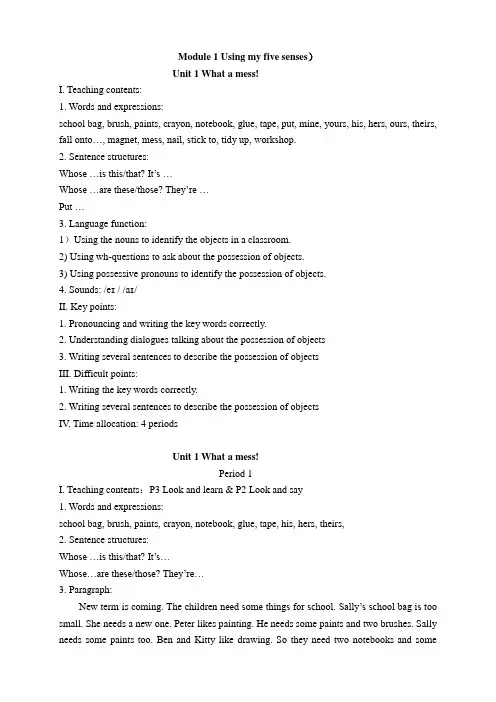
Module 1 Using my five senses)Unit 1 What a mess!I. Teaching contents:1. Words and expressions:school bag, brush, paints, crayon, notebook, glue, tape, put, mine, yours, his, hers, ours, theirs, fall onto…, magnet, mess, nail, stick to, tidy up, works hop.2. Sentence structures:Whose …is this/that? It’s …Whose …are these/those? They’re …Put …3. Language function:1)Using the nouns to identify the objects in a classroom.2) Using wh-questions to ask about the possession of objects.3) Using possessive pronouns to identify the possession of objects.4. Sounds: /eɪ / /aɪ/II. Key points:1. Pronouncing and writing the key words correctly.2. Understanding dialogues talking about the possession of objects3. Writing several sentences to describe the possession of objectsIII. Difficult points:1. Writing the key words correctly.2. Writing several sentences to describe the possession of objectsIV. Time allocation: 4 periodsUnit 1 What a mess!Period 1I. Teaching contents:P3 Look and learn & P2 Look and say1. Words and expressions:school bag, brush, paints, crayon, notebook, glue, tape, his, hers, theirs,2. Sentence structures:Whose …is this/that? It’s…Whose…are these/those? They’re…3. Paragraph:New term is coming. The children need some things for school. Sally’s school bag is too small. She needs a new one. Peter likes painting. He needs some paints and two brushes. Sally needs some paints too. Ben and Kitty like drawing. So they need two notebooks and somecrayons. Danny likes sports. He needs a football because he can play football with his classmates after school. Alice can read stories well. She needs some storybooks. Jill needs a ball and a new pencil case. She can put her tape and glue in the pencil case.4. Language function:1) Using the key words in context.2) Using wh-questions to ask about the possession of objects.3) Using possessive pronouns to identify the possession of objects.II. Key points:1) Be able to use possessive pronouns to identify the possession of objects.2) Writing several sentences to describe the possession of objects.III. Difficult points:1) Be able to describe the possession of objects correctly.2) Be able to know the different from the Nouns possessive and Adjective possessive.IV. Culture:Make your school things clean and tidy.V. Teaching aids: Multi-media, some school thingsUnit 1 What a mess!Period 2I. Teaching contents:P2 Look and say & P4 Say and act1. Words and expressions: mine, yours, ours, tidy, tidy up2. Sentence structure:Put…in/on…3. Paragraph:There are many rules for the classroom. Don’t make a mess in the classroom. Tidy up. Put your books in your school bag. Put your pencils and rubber in your pencil case. Put your pencil case in the desk. Put the rubbish in the bin. Keep our classroom clean and tidy.4. Language function:Use prepositions to indicate positions.II. Key points:Be able to use possessive pronouns to identify the possession of objects.III. Difficult points:Be able to describe the possession of objects correctly.Be able to know the different from the Nouns possessive and Adjective possessive. IV. Teaching aids: Multi-mediaUnit 1 What a mess!Period 3I. Teaching contents:P5 Listen and enjoy & Learn the sounds1. Words and expressions:scarf , *scarves, glove, gloves2. Sounds: /eɪ / /aɪ/3. Do some exercises.4. Language function:1) Using wh-questions to ask about the possession of objects.2) Using possessive pronouns to identify the possession of objects. II. Key points:Read the chant soundly.III. Difficult points:1) Identifying the pronunciation of the sounds /eɪ /and /aɪ/in words.2) Doing the exercises correctly.IV. Teaching aids: Multi-media, tape recorder, tapeUnit 1 What a mess!Period 4I. Teaching contents:P6-7 Read a story1. Words and expressions:a magic stone, workshop, nail, magnet, fall onto2. Sentence structures:What should I do?3. Passage:One day, Jim is in his father’s workshop. He sees a box. There are a lot of nails in it. Jim is playing. The box falls onto the floor. The nails ar e on the floor. Jim’s father gives him a black stone. Jim puts the stone near the nails. All the nails stick to the stone. It’s a magnet.4. Language function:Using possessive pronouns to identify the possession of objects.II. Key points:Read a story soundly.III. Difficult points:Retell the story.IV. Culture: Love your parents, because they love you.V. Teaching aids: Multi-media, a magnetModule1 Using my five senses()Unit 2 Watch it grow!Period 1Topic: Watch the animal grow!Teaching aims:Words: was, puppy, lay, *kitten, *piggy, *ponyStructure: …was…Now it is…Function:1. Understanding modeled sentences describing the growth of some insects and animals.2. Using the simple past tense to talk about past statesE.g. It was a caterpillar, now it is a cocoon.Main Points and Difficult Points:1. The pronunciation of the new word.2. Using the simple past tense properly.Culture:Help students know about the lifecycle of the animals.Teaching Aids:再构文本:It is an egg. It is white. It was an egg. It was white. Now it is a baby bird. It is small. Itis brown. It was a baby bird. It was small and brown. Now it is an adult bird. It is big. It is brown and grey.板书设计:M1U2 Watch it grow! ——Watch the animals grow!lay eggs was 是(am, is 的过去式)puppy --- dogkitten --- cat It was an egg. Now it is a chick.piggy --- pig It was a chick. Now it is a chicken.Module1 Using my five sensesUnit 2 Watch it grow!Period 2Topic: Watch the butterfly grow!Teaching aims:Words: butterfly, caterpillar, cocoon, interesting, ago, two weeks ago, after two weeks Structure: …was…Now it is…Five weeks ago, it was…Function:1. Understanding modeled sentences describing the growth of the butterfly.2. Using the simple past tense to talk about past states.Main Points and Difficult Points:1. The pronunciation of the new word.2. Using the simple past tense to describe the growth of the butterfly.Culture:Help students know about the lifecycle of the butterfly.Teaching Aids:再构文本:Five weeks ago, it was an egg. It was small and white. After some days, it was a green caterpillar. It was lovely. After two weeks, it was a cocoon. It was big and fat. Now it becomes a butterfly. It is beautiful. It has wings. It can fly in the sky.板书设计:M1U2 Watch it grow! --- Watch the silkworm grow!an egg --- a caterpillar --- a cocoon --- a butterfly… was…. Now … is…a beautiful blue butterflyModule1 Using my five sensesUnit 2 Watch it grow!Period 3Topic: Watch the silkworm grow!Teaching aims:Words and phrases: silk, worm, silkworm, lay eggs, mothSentence Structure: They were… Now they are…Function:1. Understanding modeled sentences describing the growth of the silkworm.2. Using the simple past tense to talk about past states.Main Points and Difficult Points:1. The pronunciation of the new word.2. Describe the life stages.Culture:Get to know the lifecycle of silkwormTeaching Aids:文本:They were silkworm eggs. Now they are white silkworms. They are small. They have many legs. They eat leaves. The silkworms were small. Now they are big. They eat a lot of leaves. They were big silkworms. Now they are white silkworm cocoons. They were in the cocoons. Then they came out. Now they are brown moths. They have wings. They can fly and lay eggs.板书:M1U2 Watch it grow! --- Watch the silkworm grow!silk + worm =silkworm a lot of silkegg --- small silkworm --- big silkworm --- cocoon --- moth --- lay eggsModule1 Using my five sensesUnit 2 Watch it grow!Period 4Topic: Watch the frog grow!Teaching aims:1. Words and phrases: Little Justin, born, turtle, catch flies, tadpole2. Sentence Structure: After some days, …was/were……had…Function:1. Understanding modeled sentences describing the growth of the frog.2. Using the simple present tense to talk about present states.Main Points and Difficult Points:1. The pronunciation of the new word.2. Describe the life stages of the frog.Culture:Get to know the lifecycle of frogTeaching Aids:拓展文本:At the beginning of spring, a big frog lays many eggs in the water. They are black. Some days later, the eggs become small tadpoles. They have a big round head and a long tail. They eat float grass. They have two hind legs first, and then they have two front legs. Their tails are shorter and shorter. Their bodies become brown. At last their tails disappear and they are green now. They have a smooth, moist skin, webbed feet. They can leap with long hind legs. They are beneficial insects and the friends of human being. We should protect them.板书:M1U2 Watch it grow! --- Watch the frog grow!born turtle catch flies have --- hadFirst the eggs are___________.Next they have ____________.Then they have ____. And their tails ______.After that they have ______.Finally they are ________________.Module1 Using my five sensesUnit 2 Watch it grow!Period 5Topic: Watch me grow!Teaching aims:1. Identifying the pronunciation of /ɪə/ and /eə/.2. Doing the exercises correctly3. Using the key words and sentences to talk and write about the growth of animals and insects.4. Try to use the simple past tense to say sth about the growth of people.Main Points and Difficult Points:1. To judge the sound correctly.2. Describe the life stages of the peopleCulture:Get to know how we growthTeaching Aids:再构文本:Carol was born in the USA. She was a baby. She was at home. She was so fat. She could sit and crawl here and there.When she was three, she was a lovely girl. She could walk and talk. She could read stories. She liked singing and dancing. She liked playing games.When Carol was 13-year-old, she was a hard-working student.She was good at sports. When she was 20, she could drive her car.Now Carol is a 35-year-old lady.She has 3 children. She is a doctor. On the weekend, Carol often takes her children to the park.板书:M1U2 Watch it grow! --- Watch me grow!I was____. Now I am____. My____ was____.Now my____is____.I could not _______.But now I can______.Module1 Using my five sensesUnit 3 How noisy!()Period 1Topic: The noises around us!Teaching aims:Words: drill, lorry, motorbikeStructure: What’s that noise? It’s a …Function:1. Using nouns to identify different noises.2. Using wh-questions to find out specific information.e.g. What’s that noise?Main Points and Difficult Points:1. The pronunciation of the new words.Teaching Aids:A noisy dayIt is Saturday morning. Kitty and Ben are in the street. They hear many different noises in the street. Near the bus stop, they hear a bus and some cars. And they hear a lorry. They are loud. They don’t like them. They go to the supermarket. They hear a motorbike. It’s very loud. They come home in the afternoon. Some workers are working outside their home. It’s a drill. It’s noisy. Kitty and Ben are sad. How noisy!板书设计:M1U3 How Noisy! ——The noises around us!What’s that noise? It’s a _______.drill ill---drilllorry sorry---lorrymotorbikeModule1 Using my five sensesUnit 3 How noisy!Period 2Topic: The noises at home!Teaching aims:Words: did, wanted, outside, heard, sat, watchedStructure: Kitty and Ben were at home.Kitty and Ben sat on the sofa and watched a cartoon.Function:1. Using wh-questions to find out specific information.e.g. What’s that noise?2. Using the simple past tense to talk about past states and activities. Main Points and Difficult Points:1. The pronunciation of the new word.2. Using the simple past tense to describe Kitty and Ben’s past activities. Culture:Know the noises we like or dislike.Teaching Aids:再构文本:It was Saturday afternoon. Kitty and Ben were at home. Kitty wanted to read a book. But it was too noisy outside. It was a lorry. Then Kitty wanted to do her homework. But she heard another loud noise. It was a drill. Finally, it was quiet. Kitty and Ben sat on the sofa and watched a cartoon. They heard Sam. He was sleeping.板书设计:M1U2 How noisy! --- The noises at home!It was Saturday afternoon.want---wanted hear---heardwatch—watched do----didUnit 3 How noisy!Period 4Topic: The noises in the Noise KingdomTeaching aims:Words: kingdom,loudly,quietly,loudest,shoutPhrases:the loudest noise, hear about this idea, hear the songs of the birds and the river Structure: They hear the songs of the birds and the rivers.Function:1.理解故事的主要意思。
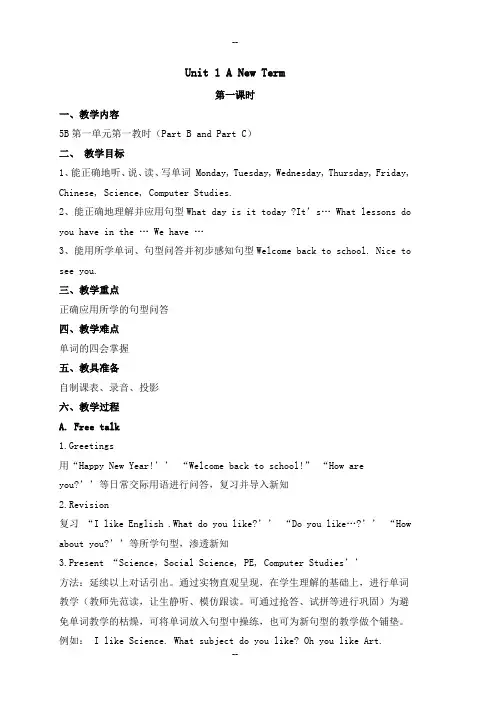
Unit 1 A New Term第一课时一、教学内容5B第一单元第一教时(Part B and Part C)二、教学目标1、能正确地听、说、读、写单词 Monday, Tuesday, Wednesday, Thursday, Friday, Chinese, Science, Computer Studies.2、能正确地理解并应用句型What day is it today ?It’s… What lessons do you have in the … We have …3、能用所学单词、句型问答并初步感知句型Welcome back to school. Nice to see you.三、教学重点正确应用所学的句型问答四、教学难点单词的四会掌握五、教具准备自制课表、录音、投影六、教学过程A. Free talk1.Greetings用“Happy New Year!’’ “Welcome back to school!” “How are you?’’等日常交际用语进行问答,复习并导入新知2.Revision复习“I like English .What do you like?’’ “Do you like…?’’ “How about you?’’等所学句型,渗透新知3.Present “Science,Social Science, PE, Computer Studies’’方法:延续以上对话引出。
通过实物直观呈现,在学生理解的基础上,进行单词教学(教师先范读,让生静听、模仿跟读。
可通过抢答、试拼等进行巩固)为避免单词教学的枯燥,可将单词放入句型中操练,也可为新句型的教学做个铺垫。
例如: I like Science. What subject do you like? Oh you like Art.Me,too. How about you/ And you? …师生示范一例,生生操练并问答表演。
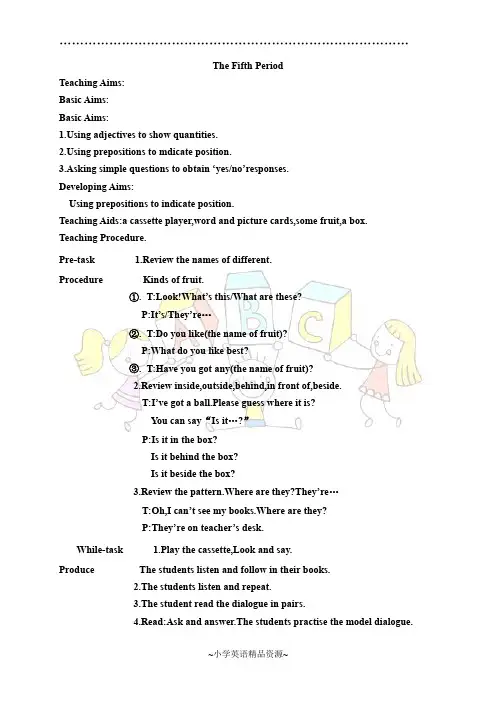
The Fifth PeriodTeaching Aims:Basic Aims:Basic Aims:ing adjectives to show quantities.ing prepositions to mdicate position.3.Asking simple questions to obtain ‘yes/no’responses.Developing Aims:Using prepositions to indicate position.Teaching Aids:a cassette player,word and picture cards,some fruit,a box. Teaching Procedure.Pre-task 1.Review the names of different.Procedure Kinds of fruit.①.T:Look!What’s this/What are these?P:It’s/They’re…②.T:Do you like(the name of fruit)?P:What do you like best?③.T:Have you got any(the name of fruit)?2.Review inside,outside,behind,in front of,beside.T:I’ve got a ball.Please guess where it is?You can say“Is it…?”P:Is it in the box?Is it behind the box?Is it beside the box?3.Review the patte rn.Where are they?They’re…T:Oh,I can’t see my books.Where are they?P:They’re on teacher’s desk.While-task 1.Play the cassette,Look and say.Produce The students listen and follow in their books.2.The students listen and repeat.3.The student read the dialogue in pairs.4.Read:Ask and answer.The students practise the model dialogue.5.Invite a few pairs to role-play the dialogue.Post-task Divide the students into groups.Activity 1.T:Suppose we’re in the fruit shop.There are ma ny fruit in it.Please make a new dialogue which is similar with‘look and say’.2.Invite some groups to role-play the dialogue in front of the class. Consolidation: Work book 4B P5 and Grammar Practice Book 4B P5.。
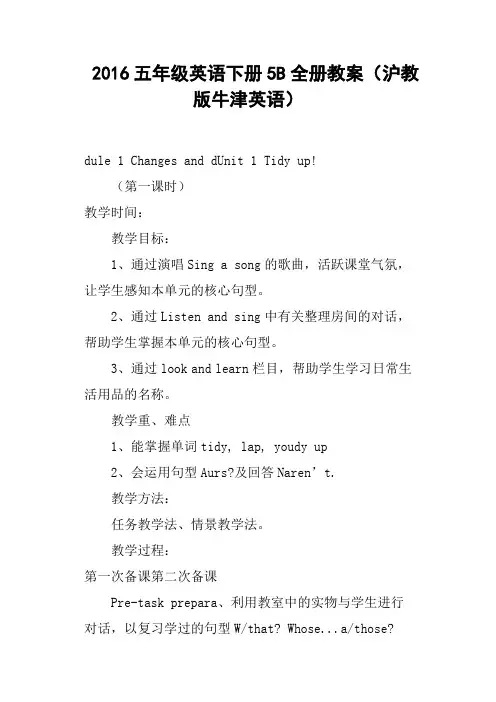
2016五年级英语下册5B全册教案(沪教版牛津英语)dule 1 Changes and dUnit 1 Tidy up!(第一课时)教学时间:教学目标:1、通过演唱Sing a song的歌曲,活跃课堂气氛,让学生感知本单元的核心句型。
2、通过Listen and sing中有关整理房间的对话,帮助学生掌握本单元的核心句型。
3、通过look and learn栏目,帮助学生学习日常生活用品的名称。
教学重、难点1、能掌握单词tidy, lap, youdy up2、会运用句型Aurs?及回答Naren’t.教学方法:任务教学法、情景教学法。
教学过程:第一次备课第二次备课Pre-task prepara、利用教室中的实物与学生进行对话,以复习学过的句型W/that? Whose...a/those?T:(a baglassroom) Whose bag/that?S1:It’s(S2’s name) ’s.T:Is this/that...?S2:Yes, it’s... / No. It’T:Whose...a/those? S3:They aT:A/?S4:are. / Naren’2、让学生欣赏Sing a song中的歌曲,病朗读歌词,然后跟唱。
唱完以后,学生还可以用身边的实物改编歌词并演唱,以初步感知本单元的核心句型。
While-tadu、教师与学生就Listen and say第一幅图片中的情景展开问答。
引出对话内容。
T:Look!This is a picture of a room. Is it tidy? Ss:N’t.T:Who aure?Ss:They are Sally and PT:What adoing?S3:They are tidying uT:(write tidyu blackboard) Yes. They are tiding it up. “tidy up “means “make it clean”. How ddy it up? Let’s l2、出示以下句子,让学生听录音后判断句子正误并改错,以检测他们是否理解了对话的大致内容。
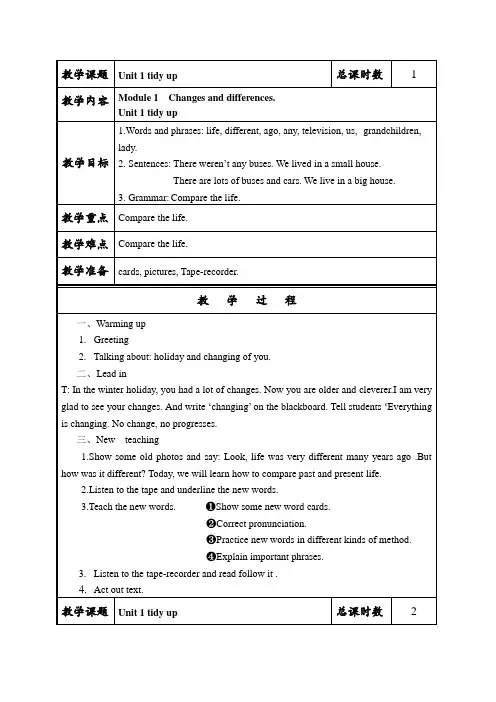
教学课题Unit 1 tidy up总课时数 1 教学内容Module 1 Changes and differences.Unit 1 tidy up教学目标1.Words and phrases: life, different, ago, any, television, us, g randchildren, lady.2. Sentences: There weren‟t any buses. We lived in a small house.There are lots of buses and cars. We live in a big house.3. Grammar: Compare the life.教学重点Compare the life.教学难点Compare the life.教学准备cards, pictures, Tape-recorder.教学过程一、Warming up1.Greeting2.Talking about: holiday and changing of you.二、Lead inT: In the winter holiday, you had a lot of changes. Now you are older and cleverer.I am very glad to see your changes. And write …changing‟ on the blackboard. Tell students …Everything is changing. No change, no progresses.三、New teaching1.Show some old photos and say: Look, life was very different many years ago .But how was it different? Today, we will learn how to compare past and present life.2.Listen to the tape and underline the new words.3.Teach the new words. ❶Show some new word cards.❷Correct pronunciation.❸Practice new words in different kinds of method.❹Explain important phrases.3.Listen to the tape-recorder and read follow it .4.Act out text.教学课题Unit 1 tidy up总课时数 2教学内容Module 1 Changs amd differences.Unit 1 tidy up教学目标1.Words and phrases: life, different, ago, any, television, us, g randchildren, lady.2. Sentences: There weren‟t any buses. We lived in a small house.There are lots of buses and cars. We live in a big house.3. Grammar: Compare the life.教学重点Compare the life.教学难点Compare the life.教学准备cards, pictures, Tape-recorder.教学过程一、Warming up1. Greeting2. Talking about: holiday and changing of you.二、Revision1. Review the new words.2. Ask the students read the text.3. Act out text.三、Practice1.Pay attention to SB unit1 part2 and copy them to make sentences.2.Show some pictures. Make some students find different in them and describe in English.四、单项选择()1. There weren‟t ___buses.A. someB. anyC. one()2 .We lived ___ a small house.A. atB. inC.on()3.Yesterday I watched TV ____my grandchildren.A. andB. withC. to()4.Thank you for____ me.A. helpB. HelpingC. helped()5.She ____ TV every day.A.watchingB. watchedC. watches.()6. It‟s a programme ___ monkeys.A. aboutB. forC. in()7.She ____ have a bike last year.A. doesn‟tB. didn‟tC. don‟t()8.My mother worked ____the fields.A. inB. onC. at()9. ---___do you go to school every day?--- I go to school by bus.A. HowB. WhatC. When()10. There ___ three books on the desk one hour ago.A. wasB. wereC. are五、Summary and homework.1.SummaryT: Today we have learnt “How to describe past and present life, review simple past tense and present tense.”2.Today‟s homeworka.Listen and read Unit1 three times, try to recite and act.pare two photos and write differences.Designs:Module 1 Changes and differencesUnit 1 tidy upweren‟t lived smallare live big教学课题Unit 2 our new home总课时数 3教学目标1.Word and phrases: fire, radio, telephone, field, hope.2.Sentences: She worked in the fields. She didn‟t have a television.3.Grammar: Talk about the life of past and now.教学重点Talk about the life of past and now.教学难点Talk about the life of past and now.教学准备cards, pictures, Tape-recorder.教学过程一.Warming up.1.Greetings.2.Act out last text.3.Free talk: Compare …Old China and New China.‟二.Lead inYesterday, Lingling saw the programme about China, she missed her grandmother very much. So she writes a letter forDaming, tells about that programme and her feeling.三.New teaching.1.Show some questions.a.What programme did Lingling watch last night?b.What was the old lady‟s life like many years ago?c.Who does Lingling miss?2.Listen to the tape-recorder and find answers.3.Learn new words.a.Show some object and cards.b.Correct pronunciation.c.Practice new words in different kinds of method.4.Listen to the tape-recorder and act out it.教学课题Unit 2 our new home总课时数 4教学目标1.Word and phrases: fire, radio, telephone, field, hope.2.Sentences: She worked in the fields. She didn‟t have a television.3.Grammar: Talk about the life of past and now.教学重点Talk about the life of past and now.教学难点Talk about the life of past and now.教学准备cards, pictures, Tape-recorder.教学过程一、Warming up1. Greetings.2. Act out last text.3. Free talk: Compare …Old China and New China.二、Revision1. Review the new words.2. Ask the students read the text.3. Act out text.三、Practise1.Play a game.Put nine cards on the desk. Two students use cards to make dialogue.For example:A: Where was he/she seven days ago?B: He/She was …A: What did he/she do there?B: He/She …2.Do A B Unit 2 exercise1.a.Listen to the tape.b.Understand generalization.c.Choose right answer.四、句型转换1. She was a teacher.(变一般疑问句)________ _________ a teacher?2. They will fly kites. (变否定句)They________ fly kites.3. They should cook vegetables. (变否定句)They ________ cook vegetables4. He visited the British Museum yesterday.(变为一般将来时态)________________________________________________________5. There were many buses. (变为一般现在时态)五、Homework(家庭作业)Introduce the great changes of our hometown/school/home.Designs:Unit 2 our new homeShe didn’t have a television.She worked in the fields.教学课题Unit 1 reading is fun总课时数 5 教学内容Module 2 work and playUnit 1 reading is fun教学目标1.Words and phrases: learnt these dancer2.Sentences: She learnt English. Did she learn any foreign languages?He is learning English now.3.Grammar: Talking about the past and present.4.Teaching properties: word cards photos tape.教学重点Talking about the past and present.教学难点Talking about the past and present.教学准备cards, pictures, Tape-recorder.教学过程Greeting: T: Hello, Good morning, class. S: Good morning, teacher.T: How are you today? S: We are well.T: What day is today? S: Thursday.T: Are you ready for your English class? S: Yes. We are ready.Game: Review the past tense of some verbs.二、New teachinge some pictures to learn important sentences.Did you/he /she …..? Yes, I/she/he did. No, ... didn‟t.He is doing …….2.Learn new words and phrases.Teacher plays the tape and have Ss underline the new words and phrases. Teacher guides to learn by all kinds of methods.3.Listen and repeat.4.Act out the test. (Give Ss some minutes to practise.)d.Practise new words in different kinds of method.5.Listen to the tape-recorder and act out it.6.教学课题Unit 1 reading is fun总课时数 6 教学内容Module 2 GrandparentsUnit 1 reading is fun教学目标1.Words and phrases: learnt these dancer2.Sentences: She learnt English. Did she learn any foreign languages?He is learning English now.3.Grammar: Talking about the past and present.4.Teaching properties: word cards photos tape.教学重点Talking about the past and present.教学难点Talking about the past and present.教学准备cards, pictures, Tape-recorder.教学过程Greetings.二、Revision1. Review the new words.2. Ask the students read the text.3. Act out text.三、Practice and consolidate.1.Show two pictures and have Ss describe (use the important sentences)2.Do activity3.Have Ss look it,give some minutes to practise in pairs ,then act it out.四、Task—fulfillingGame : teacher have Ss take out their photos and describe it. The others guess it.五、Sum the lesson.六、Homework:Try to describe the other persons to your parents.板书设计:Unit 1 reading is funShe learnt English.Did she learn any foreign languages?Yes,she did./No,she didn‟t.He is learning English now.练习:1. 按要求写单词.live(过去式)_____________ city(复数)____________ be(过去式)____________do(过去式) _____________ talk(现在分词)___________ dance(名词)___________ learn(过去式) ___________ come(现在分词)____________2. 英汉互译在田地里______________ be tired___________________努力学习______________ teach Chinese______________读书_________________ by school bus______________做蛋糕_______________ foreign languages_______________谈论_________________ learn English___________________教学课题Unit 2 at the weekend总课时数7 教学内容Module 2 GrandparentsUnit 2 at the weekend教学目标1.Words and phrases: study hard retired2.Sentences: Mr Li was a teacher. He taught Chinese.Chen Hai is an English teacher. He‟s teaching Mr Li.3. Grammar: Talk about the past and the present.教学重点Talk about the past and the present.教学难点Talk about the past and the present.教学准备word cards, pictures, Tape-recorder.教学过程一、Warming—up1. Greeting : Free talk2. Game: “What did he do?”二、New teaching1. Lead---inTeacher has a student stand in the front of the class.T: Ten years ago ,I was a student .Now, I am a teachet. Ok, let‟s come to the text.2. Important words and sentences①Listen and underline the new words. Teacher uses all kinds of methods to guide.②Show some pictures and let Ss describe them.③Listen and repeat3.Practice in pairsShow a picture of sports player .Have Ss say out the differences between the pictures.(use the important sentences)Show three pictures and have Ss compare.教学课题Unit 2 Mr Li was a teacher.总课时数8 教学内容Module 2 GrandparentsUnit 2 Mr Li was a teacher.教学目标1. Words and phrases: study hard retired2. Sentences: Mr Li was a teacher. He taught Chinese.Chen Hai is an English teacher. He‟s teaching Mr Li.3. Grammar: Talk about the past and the present.教学重点Talk about the past and the present.教学难点Talk about the past and the present.教学准备cards, pictures, Tape-recorder.教学过程一、Warming up1. Greeting:Free talk2. Game: “What did he do?”二、Revision1. Review the new words.2. Ask the students read the text.3. Act out text.三、PronunciationHave Ss listen and repeat. Put these words on the Bb. Let them find the similar pronunciation. Follow the tape two times.四、Say a poemLook. Listen and follow the tape. Then say together with actions.Introduce the great changes of our hometown/school/home.五、选词填空:who what where do did1 --- _______were you last night? --- I was at school.2 --- _______is the old lady? --- She‟s my grandma.3 --- _______ _______she do yesterday? --- She learnt English.4 --- ________they watch TV every day? --- No, they don‟t.六、Summary and homework1、Have Ss sum this lesson. Teacher gives complement.2、Write the mutation in your life.板书设计:Unit 2 at the weekendMr Li was a teacher.He taught Chinese.Chen Hai is an English teacher.He‟s teaching Mr Li.教学课题Unit 1 open day总课时数9 教学内容Module 3 things we doUnit 1 open day教学目标1. Words and phrases: email sandwiches traditional delicious2. Sentences: What did she have for breakfast/lunch/dinner?She had…3. Function: Describing eating habits教学难点Describing eating habits教学准备cards, pictures, Tape-recorder.教学过程一、Warming up:T: Hello, boys and girls.S: Hello, teacher.T: What‟s your favourite food?S: My favourite food is…二、Presentation:T: I had bread this morning, what did you have?Ss: I had rice/milk/noodles…T: We always have rice, noodles, and dumplings for meals. They are Chinese food. Do you know English food?Ss: Talk about English food which they know.T: Tell the student Daming get an email from Lingling. It‟s talk about English food.Now let‟s see what Lingling introduces. Then write the title.三、Teach new lesson:Step1 Show them some new word cards and teach them the pronunciation.Step2 Open their books; listen to the tape for the first time, ask the students to find out the new words and the name of the food.And explain some English eating habits.Step3 Give the student some questions:1. What did Daming have got?2. What did Lingling have for breakfast/lunch/dinner?Listen to the tape for the second time, ask the students to answer the question, and then check the answer together.Step4 Ask the students to see the pictures and play the tape, the students read after it. At last the students read the text in pairs.教学课题Unit 1 open day总课时数10 教学内容Module 3 English FoodUnit 1 open day教学目标1. Words and phrases: email sandwiches traditional delicious2. Sentences: What did she have for breakfast/lunch/dinner?She had…3. Function: Describing eating habits教学重点Describing eating habits教学准备cards, pictures, Tape-recorder.教学过程一、Warming up:T: Hello, boys and girls.S: Hello, teacher.T: What‟s your favourite food?S: My favourite food is…二、Revision1. Review the new words.2. Ask the students read the text.3. Act out text.三、Practice1. Ask the student to see the third part of the text. Use the sentences to make dialogues in pairs.2. 完成运用任务1:SB第一单元活动33. 完成运用任务2:列出昨晚的食谱,说说自己喜欢或不喜欢的食品。
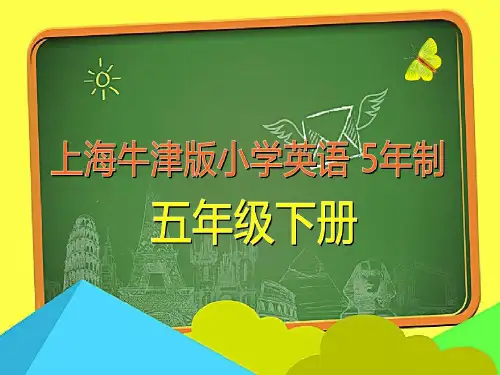
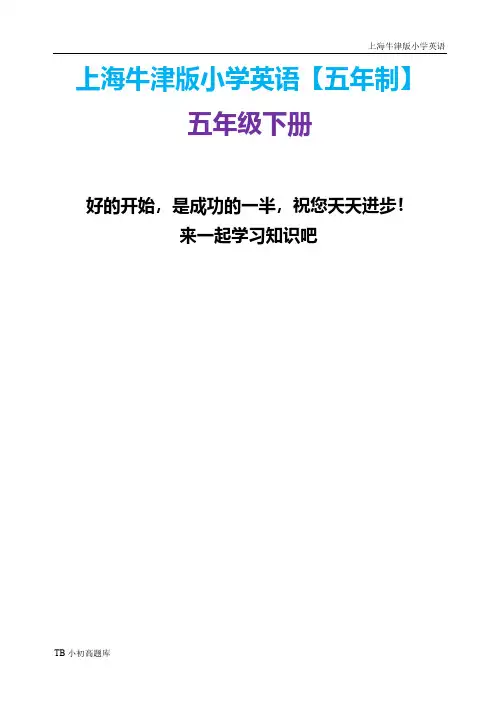
上海牛津版小学英语【五年制】五年级下册好的开始,是成功的一半,祝您天天进步!来一起学习知识吧Module2 My favourite thingsUnit 3 School subjectsPeriod 1Topic: My favourite subjectTeaching aims:Words: subject, Chinese, English, Maths, Art, Music, IT, PE,﹡poet, ﹡scientist Structure: What’s your favourite subject? My favourite subject is…What subject do you like best? I like…best.Function:1. To read and spell the new words about subjects.2. Asking and answering about the information of subjects.E.g. What’s your favourite subject? How many classes do you have?Main Points and Difficult Points:Asking and answering about the information of subjects.Culture:To tell the subject they like best and what do they want to be in the future. Teaching Aids:Student’s book , Cassette and a cassette player, Multi-mediaProcedures Contents Method PurposeⅠ、Pre-taskpreparation1. Talk2. Ask andanswer3. Elicit thetopic Show three pictures of school.Talk about the pictures.Ask and answer some questionsabout the schoole.g. What time do you come toschool?How do you come to school?We learn many things in ourschool.创设英语学习氛围,学生自由发挥说一说图片上的内容引入本课主要话题,引出新授。
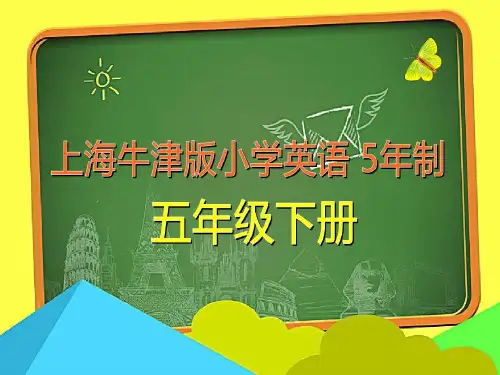
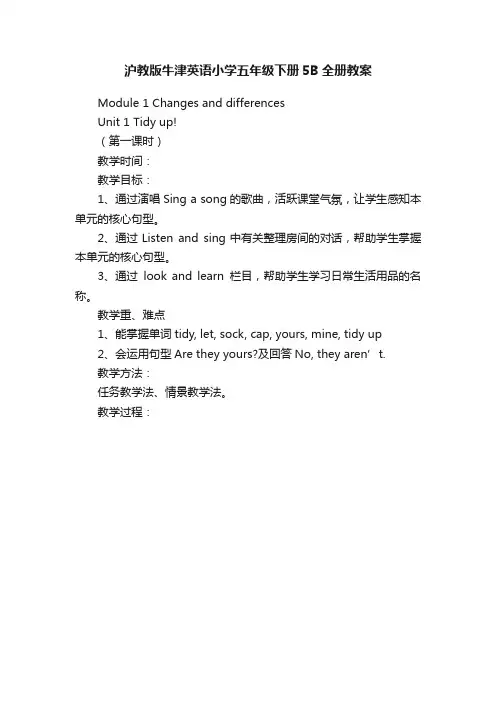
沪教版牛津英语小学五年级下册5B全册教案Module 1 Changes and differencesUnit 1 Tidy up!(第一课时)教学时间:教学目标:1、通过演唱Sing a song的歌曲,活跃课堂气氛,让学生感知本单元的核心句型。
2、通过Listen and sing中有关整理房间的对话,帮助学生掌握本单元的核心句型。
3、通过look and learn栏目,帮助学生学习日常生活用品的名称。
教学重、难点1、能掌握单词tidy, let, sock, cap, yours, mine, tidy up2、会运用句型Are they yours?及回答No, they aren’t.教学方法:任务教学法、情景教学法。
教学过程:Module 1 Changes and differencesUnit 1 Tidy up!(第二课时)教学时间:教学目标:通过Think and write 的语言输出活动,帮助学生巩固新学的语言知识。
教学重、难点1、词汇: crayon, umbrella, hers, theirs2、句型: -Whose...is this/are these?-It’s/they’re…教学方法:任务教学法、情景教学法。
教学过程:Module 1 Changes and differencesUnit 1 Tidy up!(第三课时)教学时间:教学目标:1、帮助学生通过阅读故事《神奇的石头》抓住关键信息,了解故事大意,并完成后续练习。
2、了解字母组合ar, ue, oo在单词中的发音。
3、通过学习任务(task),帮助学生巩固和综合运用本单元所学的知识和技能,描述物品的归属和应摆放的位置。
教学重、难点1、语音:ar(car), ue(blue), oo(school)2、词汇:(be) full of, a few。
教学方法:情景教学法。
教学过程:12Module 1 Changes and differencesUnit 2 Our new home!(第一课时)教学时间:教学目标:1、通过Listen and enjoy的儿歌朗读,活跃课堂气氛,并引出本单元的话题。
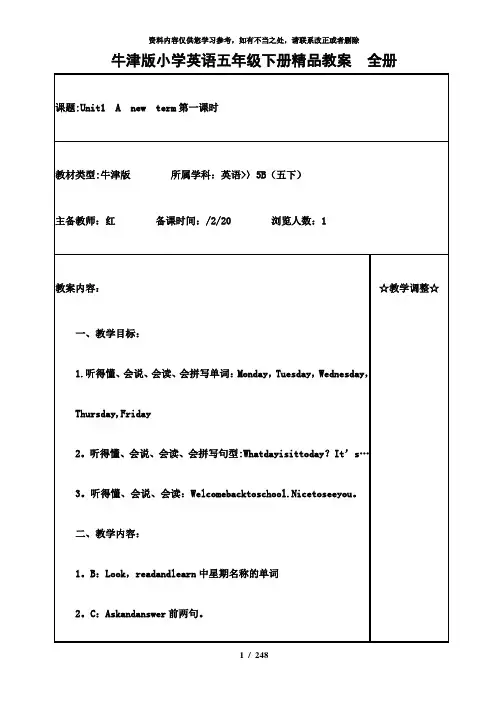
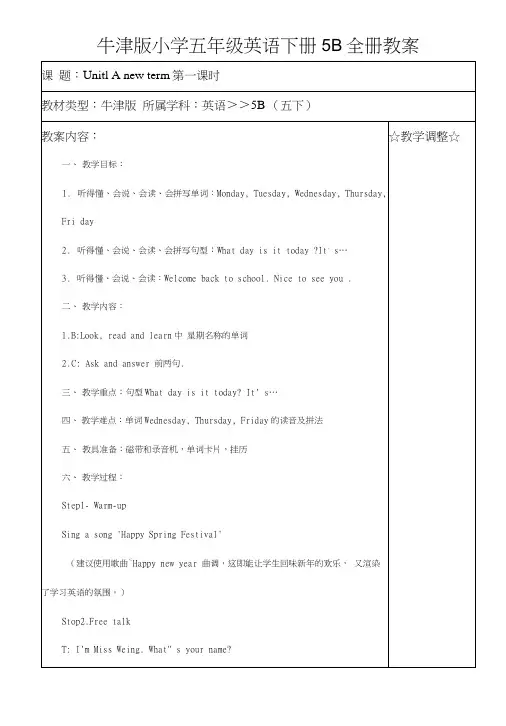
牛津版小学五年级英语下册5B全册教案教学反思:读数遍。
教学反思:教学反思:教学反思:教学反思:教学反思:Su Yang一S Helen一HS: Hello!II: Hello, may I ____________ Holen?S: ____________ Helen _____ .11: What J s _____________ you?S: ___ a headache and a _・H: __________ to hear that. I _______ you get better _____(After school)s: _________________ ?H:I 订1.S:_ you medicine?H: Yes, a lot.S: __________________ . I can ___ s ome fruit ____H: Thank you .soon.S:三练习册D/E (课前准备好图片或小黑板,出示图和对话,老师和学生一起完成对话。
)(四)Say a rhyme1Listen to the tape.2、Learn "high, just” words.3^ Follow the teacher.4^ Say it together.教学反思:课题:Unit3 Hobbies第三课时教材类型:所属学科:英语>>5B (五下)教案内容: ☆教学调整☆一、教学目标1、能熟练掌握本单元所学的有关兴趣爱好词汇。
2、能熟练掌握句型Do you have any hobbies?及其答语Yes, I do.3、能用句型I like…和He/She likes…,too.描述自己或他人的爱好和活动。
4、能用所学句型进行情景会话和交流。
二、教学重点能正确地听、说、读、写句子Do you have any hobbies?及其答语Yes, I do. 和1 like••-及He/She likes •••, too.等句型。
沪教牛津版英语五年级下册全册教案设计2021-1-27Module 1 Changes and differencesUnit 1 Tidy up!(第一课时)教学目标:1、通过演唱Sing a song的歌曲,活跃课堂气氛,让学生感知本单元的核心句型。
2、通过Listen and say中有关整理房间的对话,帮助学生掌握本单元的核心句型。
3、通过look and learn栏目,帮助学生学习日常生活用品的名称。
教学重、难点1、能掌握单词tidy, let, sock, cap, yours, mine, tidy up2、会运用句型Are they yours?及回答No, they aren’t.教学方法:任务教学法、情景教学法。
Module 1 Changes and differencesUnit 1 Tidy up!(第二课时)教学目标:通过Think and write 的语言输出活动,帮助学生巩固新学的语言知识。
教学重、难点1、词汇:crayon, umbrella, hers, theirs2、句型:-Whose...is this/are these?-It’s/they’re…教学方法:任务教学法、情景教学法。
教学过程:Module 1 Changes and differencesUnit 1 Tidy up!(第三课时)教学目标:1、帮助学生通过阅读故事《神奇的石头》抓住关键信息,了解故事大意,并完成后续练习。
2、了解字母组合ar, ue, oo在单词中的发音。
3、通过学习任务(task),帮助学生巩固和综合运用本单元所学的知识和技能,描述物品的归属和应摆放的位置。
教学重、难点1、语音:ar(car), ue(blue), oo(school)2、词汇:(be) full of, a few教学方法:情景教学法。
教学过程:Module 1 Changes and differencesUnit 2 Our new home(第一课时)教学目标:1、通过Listen and enjoy的儿歌朗读,活跃课堂气氛,并引出本单元的话题。
牛津小学英语五年级下册教案第一一、教学内容《教育程准教科牛津小学英》5B 第一元第一教(Part B and Part C)二、教学目1、能正确地听、、、写Monday, Tuesday, Wednesday, Thursday, Friday, Chinese, Science,2、能正确地理解并用句型What day is it today ?It ’s⋯What lessons do you have in the ⋯ We have ⋯3、能用所学、句型答并初步感知句型三、教学重点正确用所学的句型答四、教学点的四会掌握五、教具准自制表、音、投影六、教学程A. Free talk1.Greetings用“ Happy New Year! ’’ “! ” “ How are you?’’等日常交用行答,复并入新知2.Revision复“ I like English .What do you like?’’“Do you like⋯ ?’’“How about you?’’等所学句型,渗透新知3.Present “ Science,s’’方法:延以上引出。
通物直呈,在学生理解的基上,行教学(教先范,生静听、模仿跟。
可通答、拼等行巩固)避免教学的枯燥,可将放入句型中操,也可新句型的教学做个。
例如:I like Science. What subject do you like? Oh you like Art. Me,too. How about you/ And you?⋯生示范一例,生生操并答表演。
B. Presentation and practice1.Learn “Monday ”教自由引出,例如:Oh, someone likes PE, but someone likes English⋯Today is “Monday ”(出示自制表 ),重复,生静听、模仿跟。
延以上,引出:“What lessons do we have today? ”生听、模仿。
Module 1 Using my five senses)Unit 1 What a mess!I. Teaching contents:1. Words and expressions:school bag, brush, paints, crayon, notebook, glue, tape, put, mine, yours, his, hers, ours, theirs, fall onto…, magnet, mess, nail, stick to, tidy up, works hop.2. Sentence structures:Whose …is this/that? It’s …Whose …are these/those? They’re …Put …3. Language function:1)Using the nouns to identify the objects in a classroom.2) Using wh-questions to ask about the possession of objects.3) Using possessive pronouns to identify the possession of objects.4. Sounds: /eɪ / /aɪ/II. Key points:1. Pronouncing and writing the key words correctly.2. Understanding dialogues talking about the possession of objects3. Writing several sentences to describe the possession of objectsIII. Difficult points:1. Writing the key words correctly.2. Writing several sentences to describe the possession of objectsIV. Time allocation: 4 periodsUnit 1 What a mess!Period 1I. Teaching contents:P3 Look and learn & P2 Look and say1. Words and expressions:school bag, brush, paints, crayon, notebook, glue, tape, his, hers, theirs,2. Sentence structures:Whose …is this/that? It’s…Whose…are these/those? They’re…3. Paragraph:New term is coming. The children need some things for school. Sally’s school bag is too small. She needs a new one. Peter likes painting. He needs some paints and two brushes. Sally needs some paints too. Ben and Kitty like drawing. So they need two notebooks and somecrayons. Danny likes sports. He needs a football because he can play football with his classmates after school. Alice can read stories well. She needs some storybooks. Jill needs a ball and a new pencil case. She can put her tape and glue in the pencil case.4. Language function:1) Using the key words in context.2) Using wh-questions to ask about the possession of objects.3) Using possessive pronouns to identify the possession of objects.II. Key points:1) Be able to use possessive pronouns to identify the possession of objects.2) Writing several sentences to describe the possession of objects.III. Difficult points:1) Be able to describe the possession of objects correctly.2) Be able to know the different from the Nouns possessive and Adjective possessive.IV. Culture:Make your school things clean and tidy.V. Teaching aids: Multi-media, some school thingsUnit 1 What a mess!Period 2I. Teaching contents:P2 Look and say & P4 Say and act1. Words and expressions: mine, yours, ours, tidy, tidy up2. Sentence structure:Put…in/on…3. Paragraph:There are many rules for the classroom. Don’t make a mess in the classroom. Tidy up. Put your books in your school bag. Put your pencils and rubber in your pencil case. Put your pencil case in the desk. Put the rubbish in the bin. Keep our classroom clean and tidy.4. Language function:Use prepositions to indicate positions.II. Key points:Be able to use possessive pronouns to identify the possession of objects.III. Difficult points:Be able to describe the possession of objects correctly.Be able to know the different from the Nouns possessive and Adjective possessive. IV. Teaching aids: Multi-mediaUnit 1 What a mess!Period 3I. Teaching contents:P5 Listen and enjoy & Learn the sounds1. Words and expressions:scarf , *scarves, glove, gloves2. Sounds: /eɪ / /aɪ/3. Do some exercises.4. Language function:1) Using wh-questions to ask about the possession of objects.2) Using possessive pronouns to identify the possession of objects. II. Key points:Read the chant soundly.III. Difficult points:1) Identifying the pronunciation of the sounds /eɪ /and /aɪ/in words.2) Doing the exercises correctly.IV. Teaching aids: Multi-media, tape recorder, tapeUnit 1 What a mess!Period 4I. Teaching contents:P6-7 Read a story1. Words and expressions:a magic stone, workshop, nail, magnet, fall onto2. Sentence structures:What should I do?3. Passage:One day, Jim is in his father’s workshop. He sees a box. There are a lot of nails in it. Jim is playing. The box falls onto the floor. The nails ar e on the floor. Jim’s father gives him a black stone. Jim puts the stone near the nails. All the nails stick to the stone. It’s a magnet.4. Language function:Using possessive pronouns to identify the possession of objects.II. Key points:Read a story soundly.III. Difficult points:Retell the story.IV. Culture: Love your parents, because they love you.V. Teaching aids: Multi-media, a magnetModule1 Using my five senses()Unit 2 Watch it grow!Period 1Topic: Watch the animal grow!Teaching aims:Words: was, puppy, lay, *kitten, *piggy, *ponyStructure: …was…Now it is…Function:1. Understanding modeled sentences describing the growth of some insects and animals.2. Using the simple past tense to talk about past statesE.g. It was a caterpillar, now it is a cocoon.Main Points and Difficult Points:1. The pronunciation of the new word.2. Using the simple past tense properly.Culture:Help students know about the lifecycle of the animals.Teaching Aids:再构文本:It is an egg. It is white. It was an egg. It was white. Now it is a baby bird. It is small. Itis brown. It was a baby bird. It was small and brown. Now it is an adult bird. It is big. It is brown and grey.板书设计:M1U2 Watch it grow! ——Watch the animals grow!lay eggs was 是(am, is 的过去式)puppy --- dogkitten --- cat It was an egg. Now it is a chick.piggy --- pig It was a chick. Now it is a chicken.Module1 Using my five sensesUnit 2 Watch it grow!Period 2Topic: Watch the butterfly grow!Teaching aims:Words: butterfly, caterpillar, cocoon, interesting, ago, two weeks ago, after two weeks Structure: …was…Now it is…Five weeks ago, it was…Function:1. Understanding modeled sentences describing the growth of the butterfly.2. Using the simple past tense to talk about past states.Main Points and Difficult Points:1. The pronunciation of the new word.2. Using the simple past tense to describe the growth of the butterfly.Culture:Help students know about the lifecycle of the butterfly.Teaching Aids:再构文本:Five weeks ago, it was an egg. It was small and white. After some days, it was a green caterpillar. It was lovely. After two weeks, it was a cocoon. It was big and fat. Now it becomes a butterfly. It is beautiful. It has wings. It can fly in the sky.板书设计:M1U2 Watch it grow! --- Watch the silkworm grow!an egg --- a caterpillar --- a cocoon --- a butterfly… was…. Now … is…a beautiful blue butterflyModule1 Using my five sensesUnit 2 Watch it grow!Period 3Topic: Watch the silkworm grow!Teaching aims:Words and phrases: silk, worm, silkworm, lay eggs, mothSentence Structure: They were… Now they are…Function:1. Understanding modeled sentences describing the growth of the silkworm.2. Using the simple past tense to talk about past states.Main Points and Difficult Points:1. The pronunciation of the new word.2. Describe the life stages.Culture:Get to know the lifecycle of silkwormTeaching Aids:文本:They were silkworm eggs. Now they are white silkworms. They are small. They have many legs. They eat leaves. The silkworms were small. Now they are big. They eat a lot of leaves. They were big silkworms. Now they are white silkworm cocoons. They were in the cocoons. Then they came out. Now they are brown moths. They have wings. They can fly and lay eggs.板书:M1U2 Watch it grow! --- Watch the silkworm grow!silk + worm =silkworm a lot of silkegg --- small silkworm --- big silkworm --- cocoon --- moth --- lay eggsModule1 Using my five sensesUnit 2 Watch it grow!Period 4Topic: Watch the frog grow!Teaching aims:1. Words and phrases: Little Justin, born, turtle, catch flies, tadpole2. Sentence Structure: After some days, …was/were……had…Function:1. Understanding modeled sentences describing the growth of the frog.2. Using the simple present tense to talk about present states.Main Points and Difficult Points:1. The pronunciation of the new word.2. Describe the life stages of the frog.Culture:Get to know the lifecycle of frogTeaching Aids:拓展文本:At the beginning of spring, a big frog lays many eggs in the water. They are black. Some days later, the eggs become small tadpoles. They have a big round head and a long tail. They eat float grass. They have two hind legs first, and then they have two front legs. Their tails are shorter and shorter. Their bodies become brown. At last their tails disappear and they are green now. They have a smooth, moist skin, webbed feet. They can leap with long hind legs. They are beneficial insects and the friends of human being. We should protect them.板书:M1U2 Watch it grow! --- Watch the frog grow!born turtle catch flies have --- hadFirst the eggs are___________.Next they have ____________.Then they have ____. And their tails ______.After that they have ______.Finally they are ________________.Module1 Using my five sensesUnit 2 Watch it grow!Period 5Topic: Watch me grow!Teaching aims:1. Identifying the pronunciation of /ɪə/ and /eə/.2. Doing the exercises correctly3. Using the key words and sentences to talk and write about the growth of animals and insects.4. Try to use the simple past tense to say sth about the growth of people.Main Points and Difficult Points:1. To judge the sound correctly.2. Describe the life stages of the peopleCulture:Get to know how we growthTeaching Aids:再构文本:Carol was born in the USA. She was a baby. She was at home. She was so fat. She could sit and crawl here and there.When she was three, she was a lovely girl. She could walk and talk. She could read stories. She liked singing and dancing. She liked playing games.When Carol was 13-year-old, she was a hard-working student.She was good at sports. When she was 20, she could drive her car.Now Carol is a 35-year-old lady.She has 3 children. She is a doctor. On the weekend, Carol often takes her children to the park.板书:M1U2 Watch it grow! --- Watch me grow!I was____. Now I am____. My____ was____.Now my____is____.I could not _______.But now I can______.Module1 Using my five sensesUnit 3 How noisy!()Period 1Topic: The noises around us!Teaching aims:Words: drill, lorry, motorbikeStructure: What’s that noise? It’s a …Function:1. Using nouns to identify different noises.2. Using wh-questions to find out specific information.e.g. What’s that noise?Main Points and Difficult Points:1. The pronunciation of the new words.Teaching Aids:A noisy dayIt is Saturday morning. Kitty and Ben are in the street. They hear many different noises in the street. Near the bus stop, they hear a bus and some cars. And they hear a lorry. They are loud. They don’t like them. They go to the supermarket. They hear a motorbike. It’s very loud. They come home in the afternoon. Some workers are working outside their home. It’s a drill. It’s noisy. Kitty and Ben are sad. How noisy!板书设计:M1U3 How Noisy! ——The noises around us!What’s that noise? It’s a _______.drill ill---drilllorry sorry---lorrymotorbikeModule1 Using my five sensesUnit 3 How noisy!Period 2Topic: The noises at home!Teaching aims:Words: did, wanted, outside, heard, sat, watchedStructure: Kitty and Ben were at home.Kitty and Ben sat on the sofa and watched a cartoon.Function:1. Using wh-questions to find out specific information.e.g. What’s that noise?2. Using the simple past tense to talk about past states and activities. Main Points and Difficult Points:1. The pronunciation of the new word.2. Using the simple past tense to describe Kitty and Ben’s past activities. Culture:Know the noises we like or dislike.Teaching Aids:再构文本:It was Saturday afternoon. Kitty and Ben were at home. Kitty wanted to read a book. But it was too noisy outside. It was a lorry. Then Kitty wanted to do her homework. But she heard another loud noise. It was a drill. Finally, it was quiet. Kitty and Ben sat on the sofa and watched a cartoon. They heard Sam. He was sleeping.板书设计:M1U2 How noisy! --- The noises at home!It was Saturday afternoon.want---wanted hear---heardwatch—watched do----didUnit 3 How noisy!Period 4Topic: The noises in the Noise KingdomTeaching aims:Words: kingdom,loudly,quietly,loudest,shoutPhrases:the loudest noise, hear about this idea, hear the songs of the birds and the river Structure: They hear the songs of the birds and the rivers.Function:1.理解故事的主要意思。